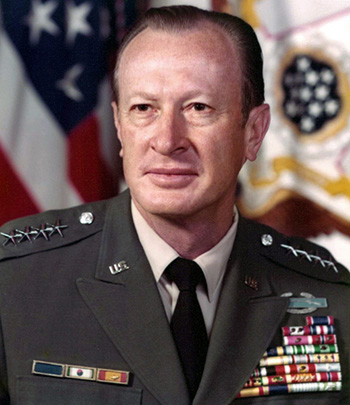
|
Frederick C. Weyand |
 |
|||
| Rank, Service | ||||
General O-10, U.S. Army |
||||
| Veteran of: | ||||
|
||||
| Tribute: | ||||
Frederick Weyand was born on September 15, 1916, in Arbuckle, California. He was commissioned a 2d Lt of Artillery through the Army ROTC program at the University of California at Berkeley on May 6, 1938, and served in the Coast Artillery Corps Reserve until going on active duty beginning December 9, 1940. Lt Weyand served as Personnel Officer with the 6th Artillery Regiment in the U.S. from December 1940 to June 1942, followed by Command and General Staff School at Fort Leavenworth, Kansas, from July to August 1942. His next assignment was as Personnel Officer with the Harbor Defense Command in San Francisco, California, from September 1942 to December 1943, and then as an Intelligence Officer in the Office of G2 on the War Department General Staff in Washington, D.C., from January to April 1944. LtCol Weyand next served as the Assistant Chief of Staff for Intelligence with U.S. Army Forces, China-Burma-India Theater and from May 1944 to February 1945, followed by service as an Intelligence Officer with Headquarters China Theater in Chungking, China, from March to September 1945. His next assignment was with the Military Intelligence Service in Washington, D.C., from October 1945 to July 1946, and then as Assistant Chief of Staff for Intelligence with U.S. Army Forces Middle Pacific from August 1946 to August 1949. He attended the Infantry School at Fort Benning, Georgia, from September 1949 to July 1950, and then served as the Deputy Chief of Staff for the 3rd Infantry Division in Korea from August to December 1950. Col Weyand next served as Commander of 1st Battalion, 7th Infantry Regiment in Korea from January to July 1951, followed by service as Assistant Chief of Staff for Operations with the 3rd Infantry Division in Korea from August to December 1951. He served as Committee Chairman of the Tactical and Academic Departments of The Infantry School at Fort Benning from January 1952 to January 1953, and then attended Armed Forces Staff College in Norfolk, Virginia, from February to July 1953. His next assignment was as a Military Assistant in the Office of the Secretary of the Army at the Pentagon from August 1953 to July 1957, followed by National War College in Washington, D.C., from August 1957 to May 1958. He served as Commander of the 3rd Battle Group with the 6th Infantry Regiment in West Germany from June 1958 to December 1959, and he then served in the Office of the U.S. Commander in Berlin from January to June 1960. Col Weyand next served as Chief of Staff for the Communications Zone with U.S. Army Europe from July 1960 to April 1961, followed by service as Deputy Chief and then Chief of Legislative Liaison for the Department of the Army from April 1961 to August 1964. Gen Weyand served as Commanding General of the 25th Infantry Division at Schofield Barracks, Hawaii, from August 1964 to March 1966, and then in South Vietnam from March 1966 to March 1967. He served as Deputy Commanding General of II Field Force with U.S. Military Assistance Command in South Vietnam from March to May 1967, and then as Commanding General of II Field Force from May 1967 to July 1968. His next assignment was as Chief of the Office of Reserve Components with Headquarters U.S. Army in the Pentagon from August 1968 to March 1969, followed by service as Military Advisor to the Chairman of the U.S. Delegation with the U.S. Embassy in Paris, France, from March 1969 to June 1970. Gen Weyand served as Assistant Chief of Staff for Force Development with Headquarters U.S. Army from June to August 1970, and then as Deputy Commander of U.S. Military Assistance Command in South Vietnam from September 1970 to June 1972. He served as the last Commander of U.S. Military Assistance Command Vietnam from June 1972 to March 1973. Gen Weyand next served as Commander in Chief of U.S. Army Pacific from March to July 1973, and then as Vice Chief of Staff of the U.S. Army from August 1973 to October 1974. His final assignment was as Chief of Staff of the Army from October 3, 1974, until his retirement from the Army on October 1, 1976. Frederick Weyand died on February 10, 2010, and was buried at the National Memorial Cemetery of the Pacific in Honolulu, Hawaii. |
||||
|
||||

